Key Features
- Price: 380 USD (CLICK TO BUY)
- Release Date : 27th January 2021
- ATX Form Factor / 6 PCB Layers
- INTEL Z590 chipset
- LGA1200 CPU socket
- CPU Support
- Intel 10th Gen CORE CPU
- Intel 11th Gen CORE CPU
- 4 x 32GB 5,533 MHz DDR4, maximum 128 GB
- 3 x PCIe x16
- Back IO :
- Display Port 1.4
- HDMI 2.0
- Flash BIOS button
- 2 x USB 2.0 — RX/TX 480 Mbps
- 3 x USB 3.2 2nd gen. Type-A+C — RX/TX 10 Gbps
- 1 x USB 3.2 dual channel TYPE-C — RX/TX 20 Gbps
- 4 x USB 3.2 (1st Gen) — RX/TX 5 Gbps
- 2x surge protected 2.5Gbps LAN controller
- Realtek ALC4080 Codec 7.1 channels audio,
- STORAGE
- 4 x M.2 SSD
- 6 x SATA 3 — RX/TX 6 Gbps
- MULTIPLE GPU
- Nvidia SLI
- AMD Crossfire
- 70 AMPS power stages
- Great passive Cooling elements
- 6 layered PCB ( PCIe 4.0 ready)
- Q-Led screen
- 5,333 MHz RAM clock
- WiFi 6E support
- New ALC 4080 audio codec
- No hybrid fan connectors
- 5th RGB connector unnecessary and awkwardly placed
- No single slot PCIe export
On the 27th of January, ASUS will be releasing its Intel Z590 powered family of motherboards. This year launch is especially important for Intel since it is releasing its first ever PCIe 4.0 enabled processor, and the STRIX is especially important to ASUS because it is the most thought after, scrutinized board on the market.
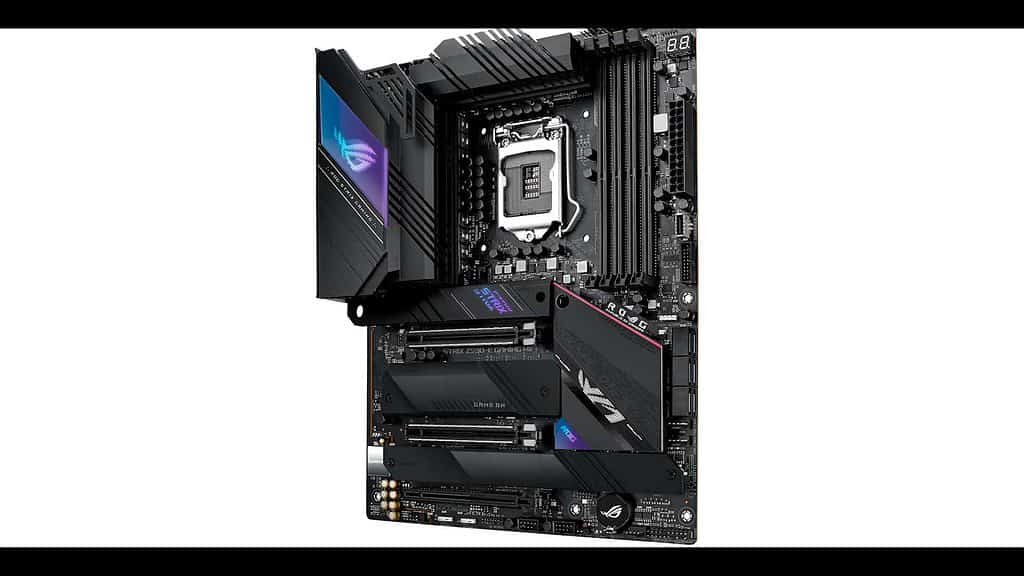
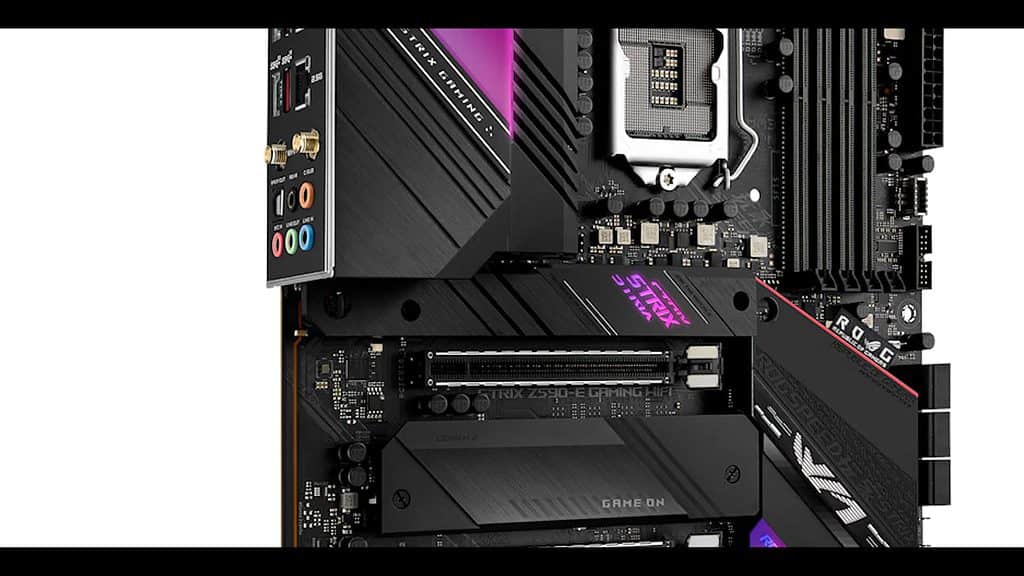
- 6 SATA cables
- Thermistors
- Q-connector
- M.2 SSD screws and screw raisers
- RGB cable extension
- WiFi 6E antenna
- VRM fan holder
- ROG cable Velcro strap
- ROG stickers
- ROG coaster
- Manual
- DVD driver & Software
PCB
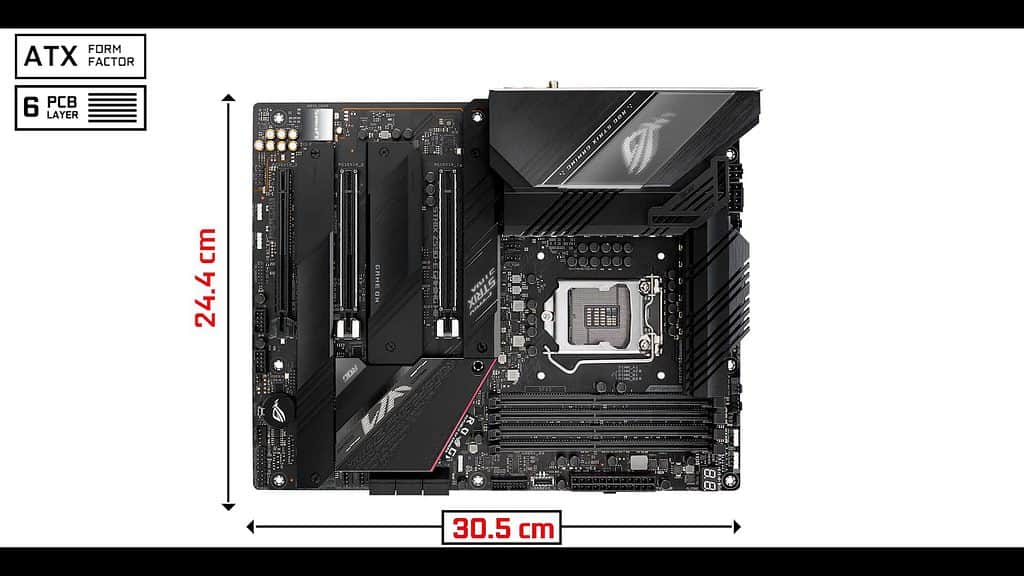
We are dealing with a 6 layered PCB ATX motherboard. Totally expected from a PCIe 4.0 enabled motherboard. Having more PCB layers (typically only 4) adds PCIe signal isolation which will allow a stable PCIe 4.0 support.
It also will benefit VRM heat dissipation and audio quality. Obviously, a very solid foundation for a performant and durable motherboard.
LGA 1200
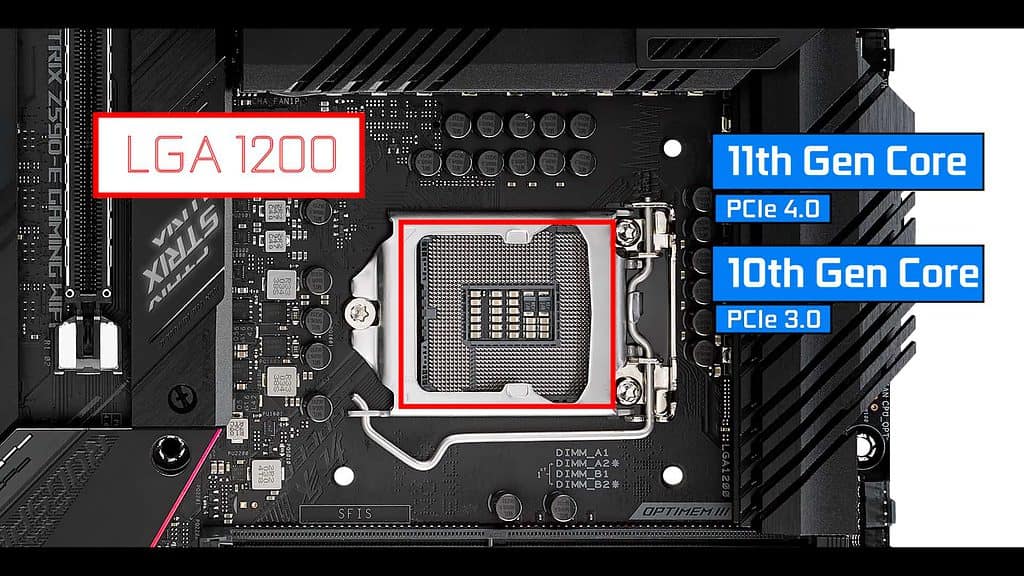
Our LGA1200 socket can support :
- 10 the Gen Intel CORE CPU
- 11 the Gen Intel CORE CPU
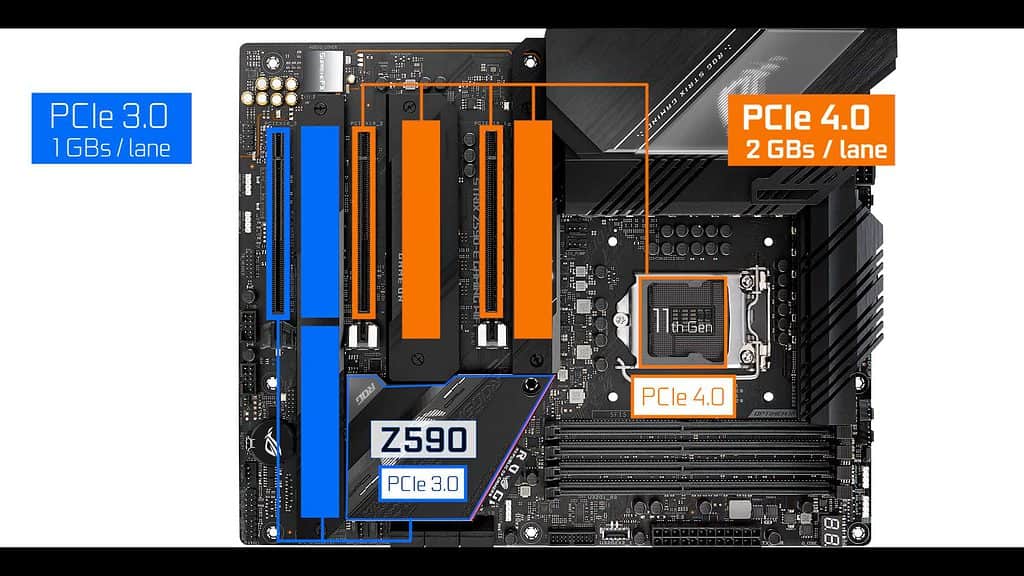
Worth noting only the incoming 11th gen Intel CORE CPU is PCIe 4.0 enabled which has its importance since it will feed our several components with double the bandwidth the PCIe 3.0 can.
The chipset fed components will remain PCIe 3.0 only compliant in any cases.
VRM
This is where ASUS really did well!
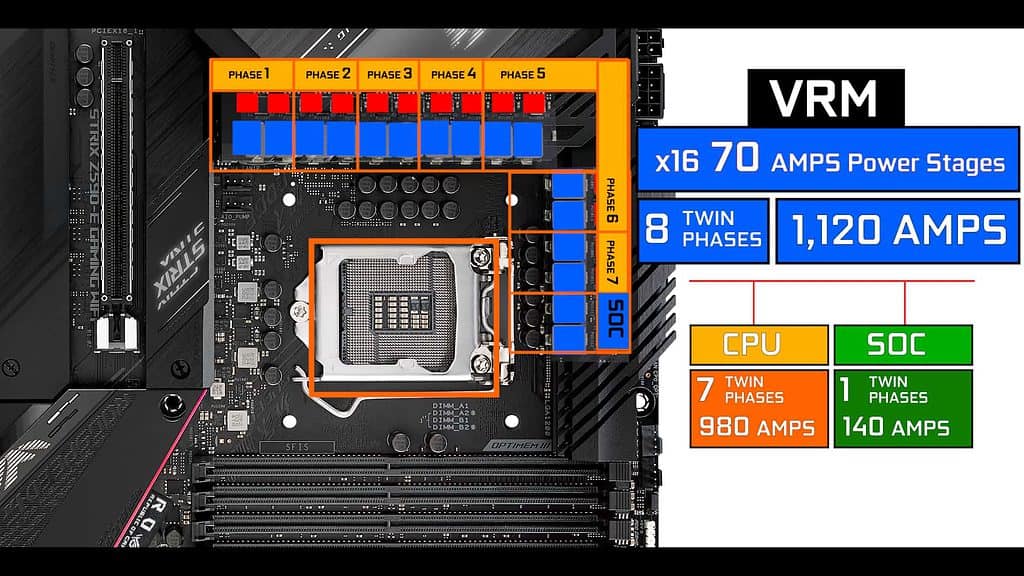
It has nothing to do with its predecessors, and truly is an unprecedent leap forward.
We have 16 70 AMPS Powers stages for a total of 1120 AMPS organized in 8 twin phases, 7 of which are CPU centric.
Some of you might rightfully ask: Why would we have 1120 amps worth of power to run up-to a 8 core CPU?
The short answer is marketing and thermals.
Obviously half that would have been enough to run and even overclock any of the 10th or 11th gen Intel CORE CPU, but using a fraction of a 70 AMPS power stages doesn’t heat as much as a maxed-out 40 amps power stage.
Heat wise
First, we have a 6 layered PCB, meaning a greater heat dissipation through the board,
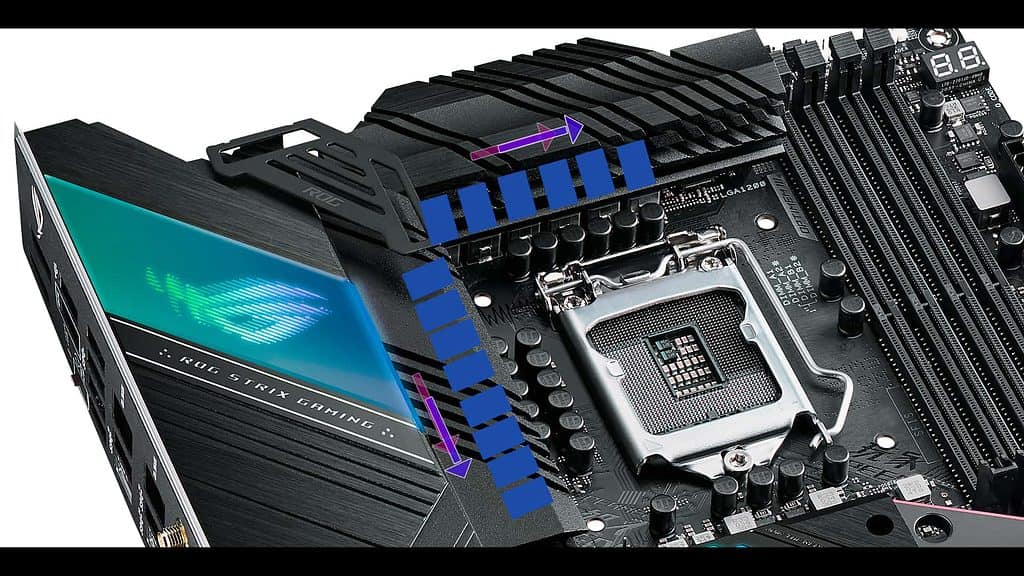
The overall power draw is shared amongst 14 power stages, in effect spreading the heat all around. This should give us one of the most powerful and coolest VRM seen on a STRIX series to date!
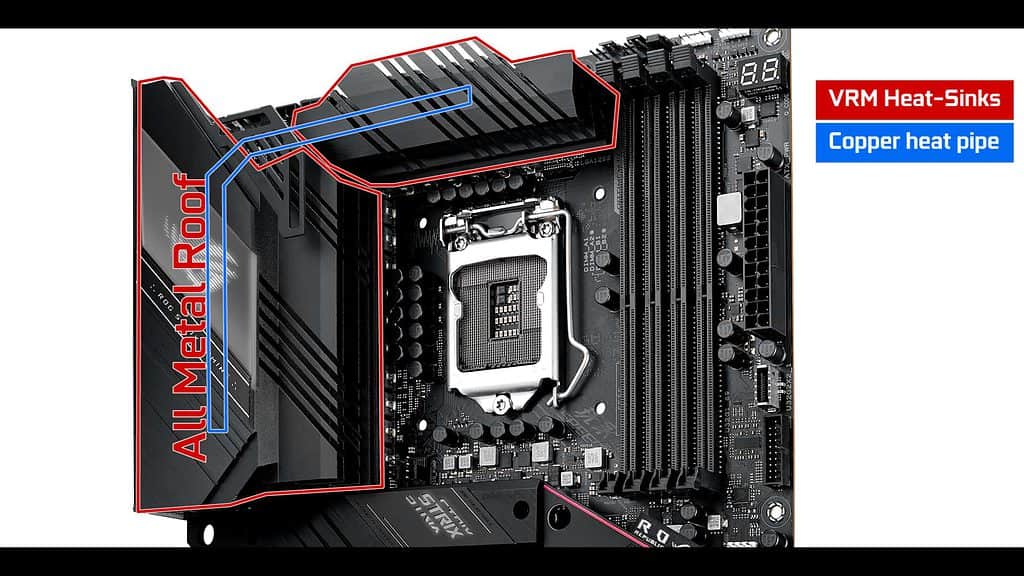
We have massive 2 stages, copper pipe linked heat-sink which should do a rather good job at radiating that massive VRM heat away.
The 1st stage is this imposing all metal piece of metal with an all-metallic IO roof. I first saw this feature on MSI’s X570 UNIFY motherboard, but absolutely love to see it bleed out in the industry.
In all and for all, I do expect this VRM temps to be well within thermo-throttling bounds with peaks at around 65C (PCB), on a copiously over-clocked i9-11900K.
RAM
The ROG STRIX Z590-E Gaming can support up to 128 GB of DDR4 ram in a dual channel configuration.

It is overclockable up to a novel 5,333 GHz ( in a single DIMM configuration ) which is noticeably more than its Z490 predecessor (533 MHz more).
Populating more memory slots will result in slower shared clocks :
- 1DPC 1R max speed 5333 MHZ
- 1DPC 2R max speed 4600 MHZ
- 2DPC 1R max speed 4000 MHZ
- 2DPC 2R max speed 3800 MHZ
M.2 SSD
Our board can support up-to 4 M.2 SSD, which is obviously unprecedented for a STRIX board. But there is a catch!
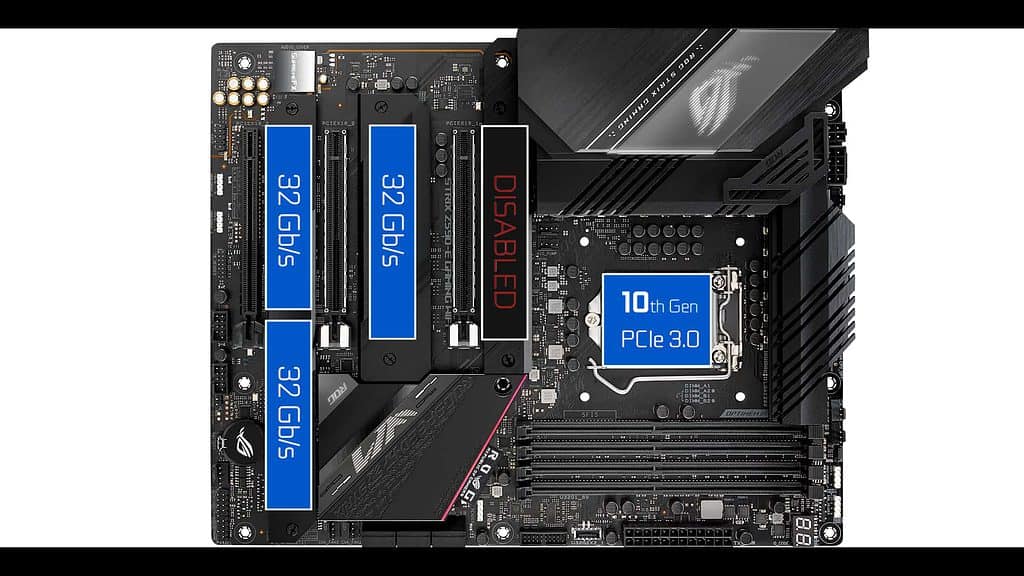
Couple this board with a 10th Gen Intel CORE CPU, and ‘only’ three M.2 SSD connectors will be usable, at PCIe 3.0 standard, meaning up to 32 Gbs each.
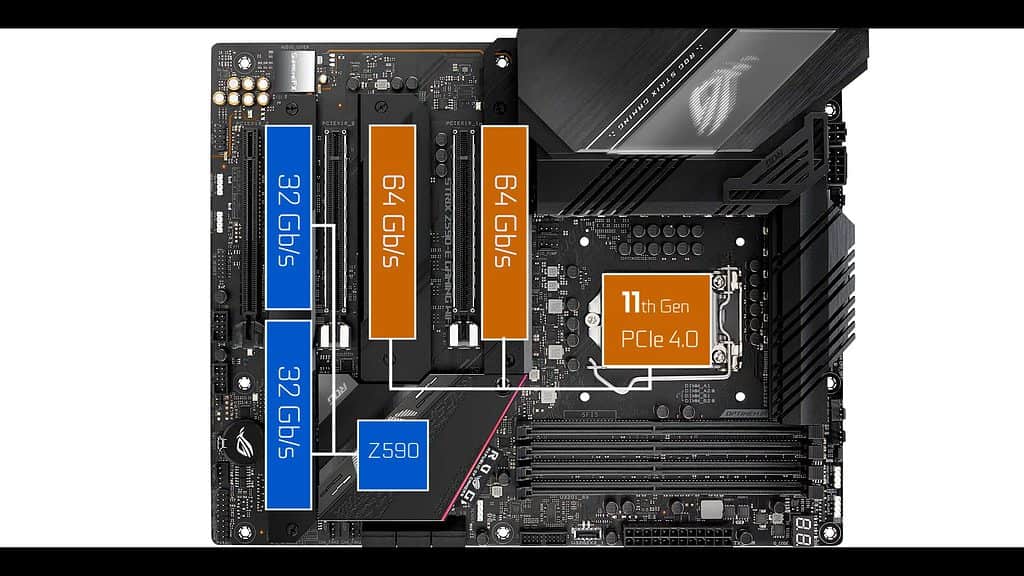
But if coupled with a 11th GEN Intel CORE CPU, your board can now support up-to 4 M.2 SSDs, 2 of which can transfer data at PCIe 4.0 bandwidth levels, meaning up to a whooping 64 Gbs.
Obviously this will produce quite a bit of heat.
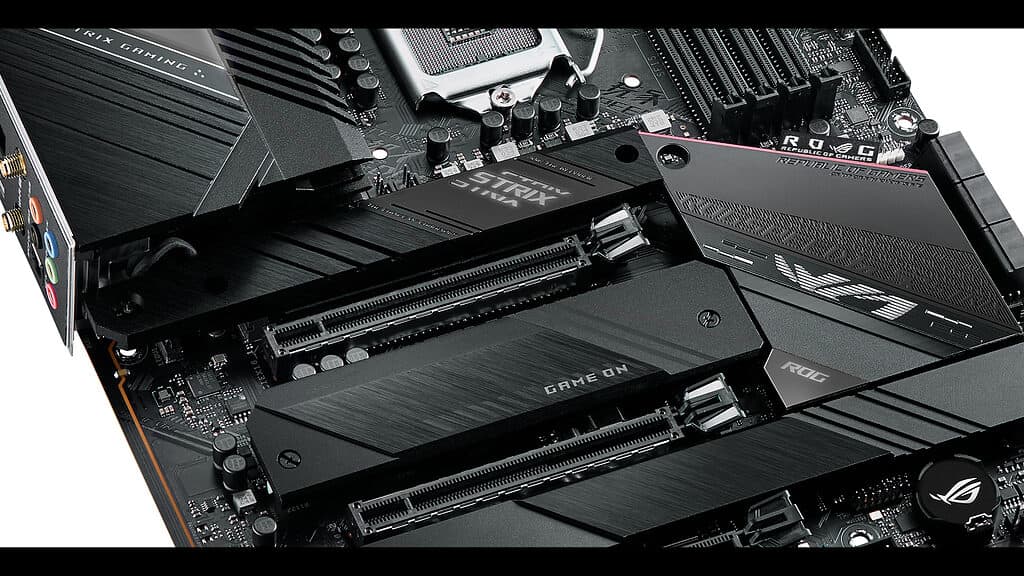
Fortunately , we do have rather impressive thermo-padded heat-shields which do a wonderful job at keeping our stick cool in any usage condition.
I will note that the last 2 M.2 SSDs so share a common (very) long heat sink. I do have reserves on how fast that plate can radiate heat away, and shall definitely take a closer look at tit once I get a chance to play around with this board.
Chipset
Despite many early reports, the Z590 Chipset does not house any PCIe 4.0 lanes. Instead it has the same 24 PCIe 3.0 lanes as seen on its Z490 predecessor.
In addition it can redirect the 11th Gen Intel CORE CPU 20 PCIe 4.0 lanes to some of the board components ( on this board, a PCIe 16 export slot and M.2 SSD connector).
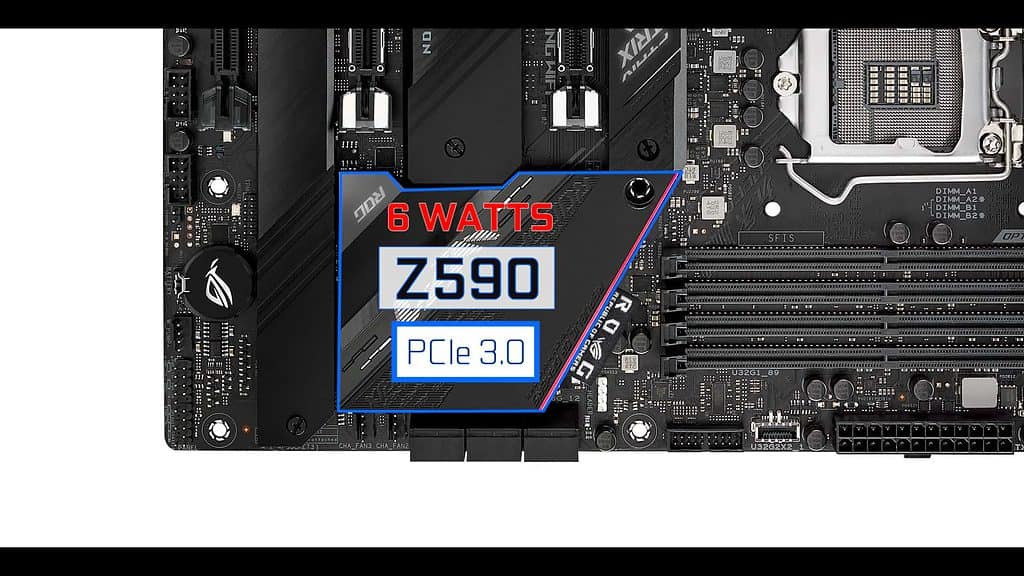
Is it a bad thing? Not necessarily.
On one hand it keeps our chipset cold enough not to require an active cooling solution as seen on the boiling 11 watts X570 chipset, and on the other, the motherboard still benefits from the PCIe 4.0 standard brought in by its CPU.
As a result, we have a cooler, more affordable and arguably more durable motherboard.
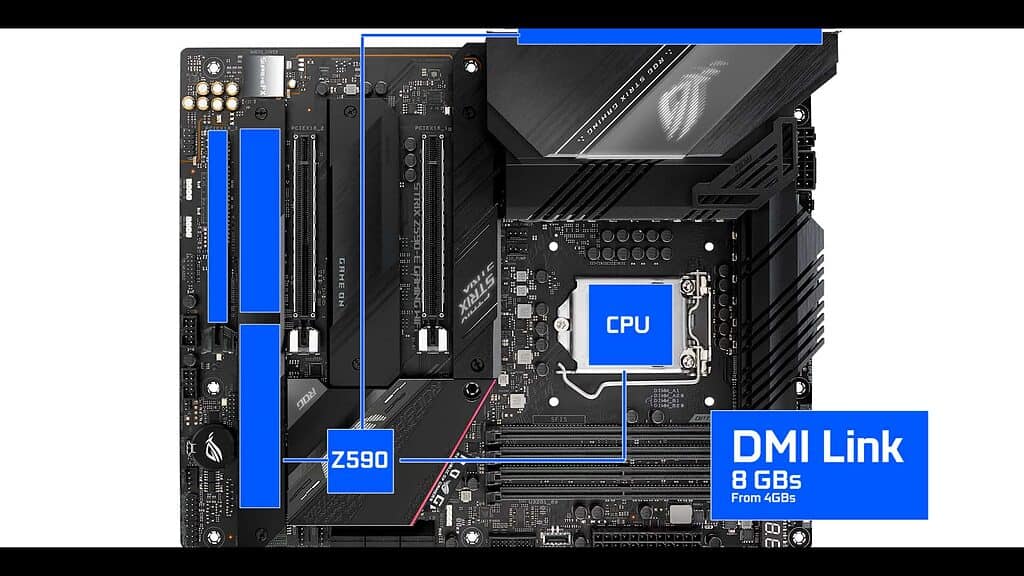
The most noticeable upgrades are :
- an upgrade DMI link which allows x8 PCI-e lane (8 GB/s) data swap between the chipset and the CPU. That is double what we have seen on the past few generations of Z powered motherboards.
Something which definitely benefit the overall bandwidth capacity of our board. - Thunderbolt 4.0
- More USB supports ( special note for the USB 3.2 dual channel 20 Gbs TYPE-C ).
SATA 3.0
For more classical storage solutions, we have our usual SATA 3.0 plugs. 6 in total, with a transfer rate of 6 Gbps each. They can be configured to run into a 0,1, or 10 RAID configuration.
PCIe Slots
The ROG STRIX Z590-E Gaming has 3 PCI expresses slots.:
- 3 16 lanes with different BUS speeds
- NO single lanes , single speeds
Only the closest one to your CPU can deliver up to 16 Lanes worth of bandwidth meaning, this is where you’d want your video card to be placed for optimal performances.
In a dual GPU configuration, lanes are split in a 8 by 8 PCIe lane configuration. Hence the metallic reinforcements.
Note that this board is both SLI (x2) and CROSSFIRE (x2) compatible.
Our last and naked 16 slots is capped at 4 PCIe lanes, not exactly GPU friendly.
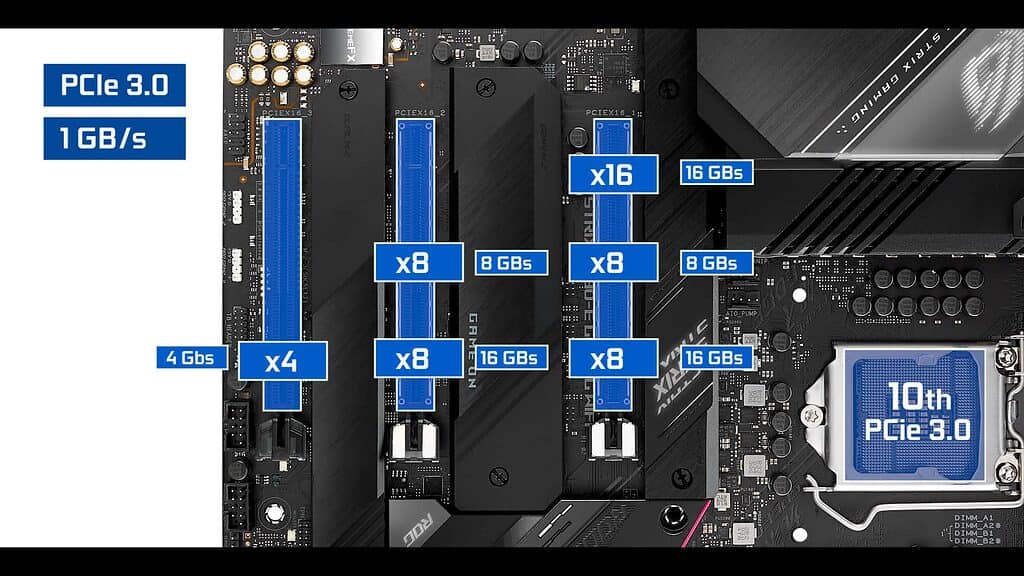
Coupled with a 10th Gen Intel CORE CPU, all of our PCIe slot will output bandwidth at a 1 GBs rate.
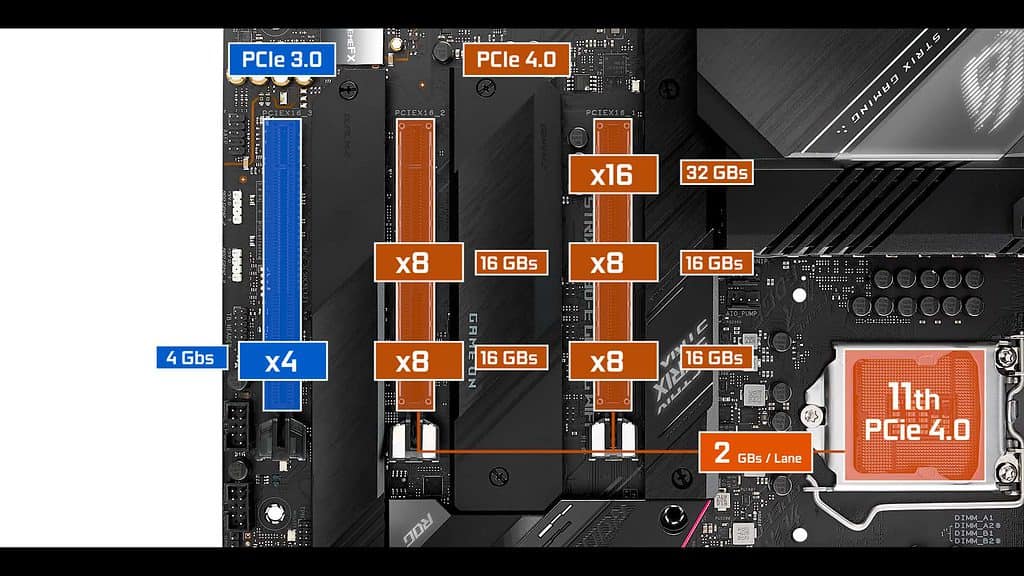
But if coupled with a 11th Gen. Intel CORE CPU, our 2 first PCIe 16 slots can output PCIe 4.0 bandwidth levels meaning 2 GB/s per lane.
Worth noting that, with the current bandwidth outputs of AMD or Nvidia graphics cards, there are no performance gains between PCIe 3 or PCIe 4 standards.
It is great for future proofing (and marketing), but that’s about it .
Back IO

First let me note the presence of an IO integrated plate which is always a good point!
- 2x display outputs for our integrated graphics (HDMI 2.0 / DP 1.4), both of which can output 4096×2160 @60Hz.
- 2x 2nd Gen USB plugs (480 Mbps)
- 4x 3rd Gen USB plugs (5 Gb/s)
- 4x 3.2 2nd GEN USB plus , including 2 type C (10 Gb/s each)
- Note that one of the TYPE-C is dual channel meaning that it can output up to 20 Gb/s worth of data.
- 2x surge protected (ASUS LANGUARD) Intel I225-V 2.5Gbps LAN controller which is definitely a plus for streamers.
- a WiFi 6E AX201 with transfer up to 9.6 Gb/s, and able to broadcast at 6GHz frequency.
- an upgrade worth noting since it multiplies several folds the transfer bandwidth level than previously available (2.4 Gb/s on the ROG STRIX Z490-E Gaming WIFI).
- a ALC 4080 REALTEK audio codec, which is a first. REALTEK as not yet published any specs concerning this new codec, but we can assume that the main add-on here is the 2-way AI noise cancellation technology which will find itself particularly useful to streamers, gamers and content creators alike.
Front Panel Connectors
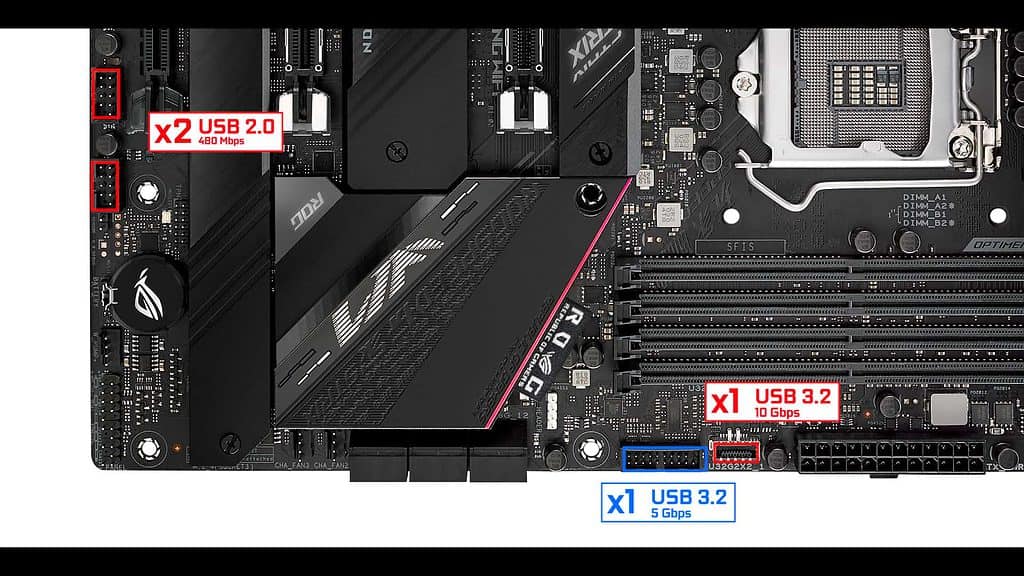
We have :
- 2x 2nd gen USB front panel connectors , good for our AIO pumps, or PSU monitoring,
- 1x 5Gbs USB 3.2 (1st Gen) front panel Connector
- 1x 10Gbs USB 3.2 (2nd Gen) TYPE-C front panel Connector
Overall a well furnished board-based peripherals in par with its pricing.
Note the presence of the new THUNDERBOLT 4.0 connector, allowing up to 40 Gbps transfer (same as in Thunderbolt 3.0) and energy output upto 60Watts (new).
Cooling connectors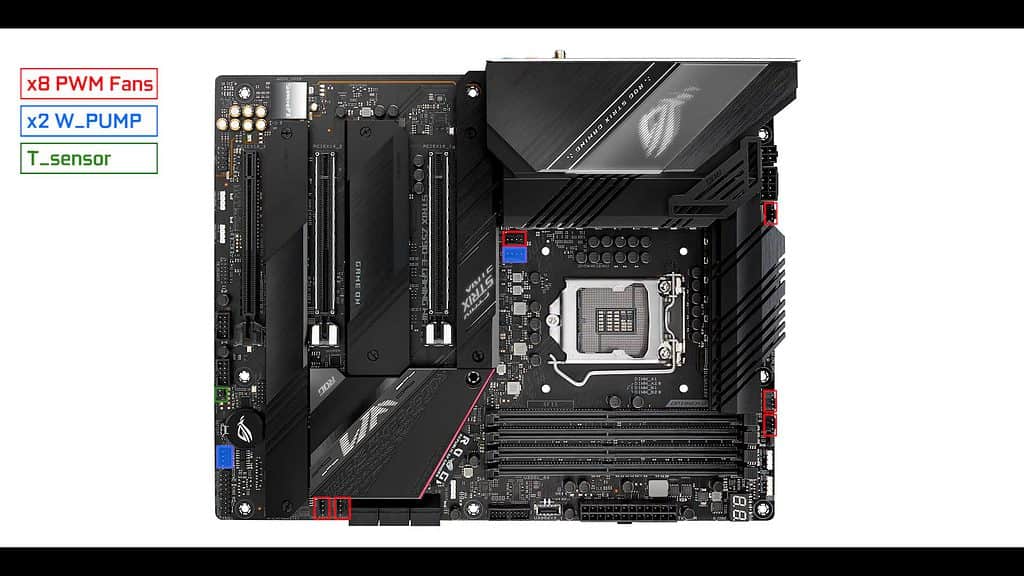
We have 8 nested PWM FAN connectors, 2 of which can support a water pump (AIO or dedicated)
Definitely what you want to see on an enthusiast driven board. The ROG STRIX Z590 -E Gaming can handle about any cooling solutions you will throw at it. Spanning from the classic air to the eccentric dual-loop custom water cooling apparatus.
Only regret here, is the fact that these connectors are not Hybrids which could support anything you’d throw at it, whether a fan, a water pump or a flow sensor.
I would have given this boards an unprecedented level of agility which enthusiast would have most certainly appreciate.
EZ Debugger
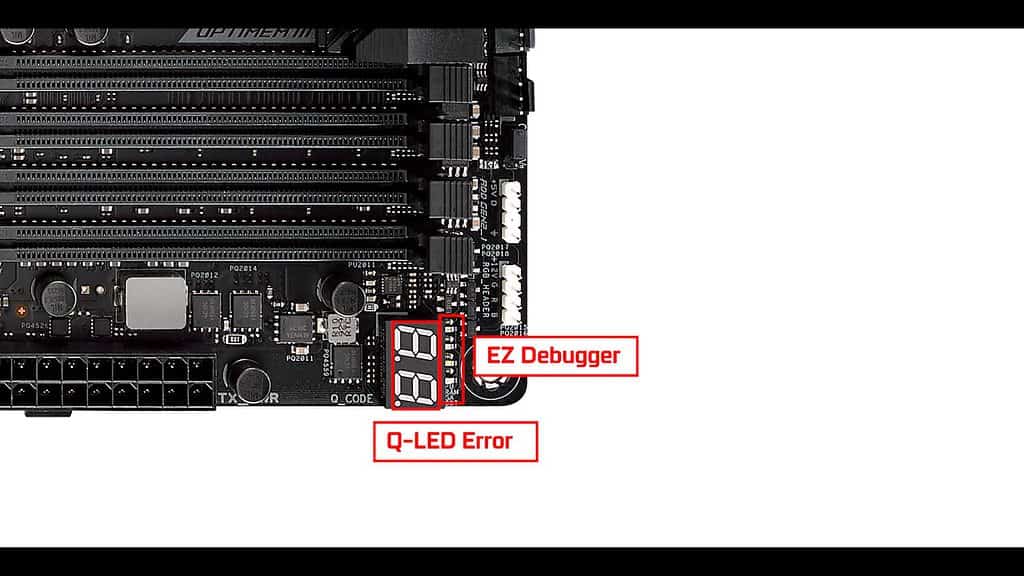
The EZ debugger is really the a crucial must-have on PCIe 4.0 enabled boards. More often than not, enthusiasts can’t resist the call to find their RAM or CPU overclocking limits, and fail boots becomes a daily incidence.
The EZ debugger will give us a first-aide troubleshooting guidance one what stage of the boot your system failed.
It is further refined by a precise Q-LED error which will pin-point any current software or hardware problems.
AURA Sync Effect
RGB wise, our ROG STRIX Z590 -E Gaming has 3 nested RGB strips :
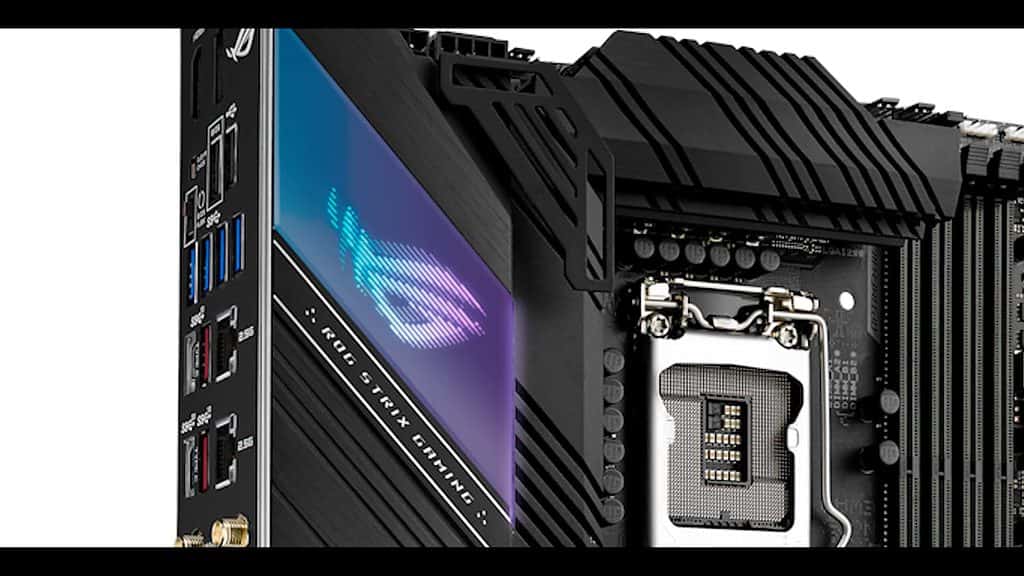
One under our IO roof.

one under our first m.2 SSD heat-shield
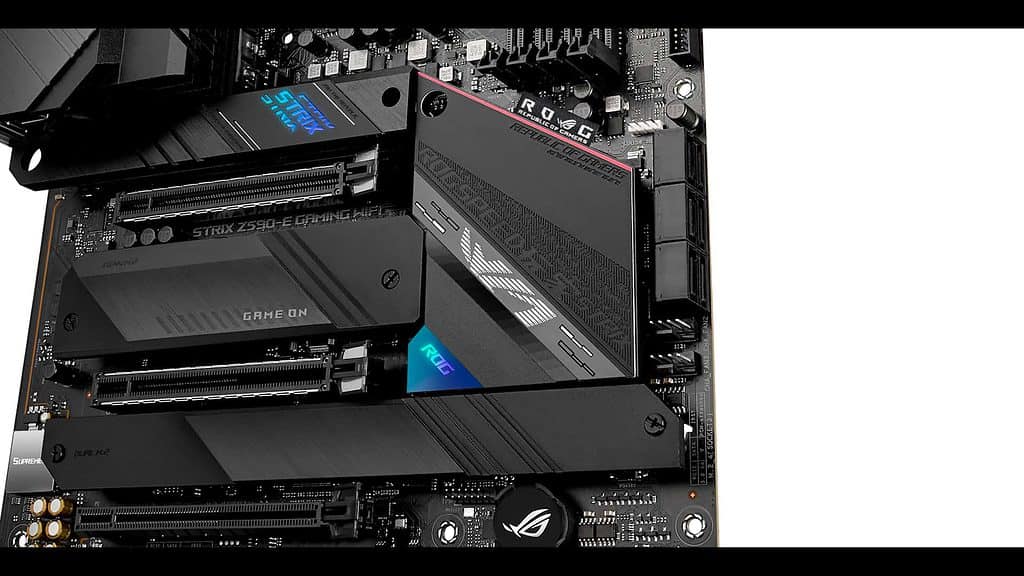
and a final one on the corner of our chipset heatsink
In addition we also have 5 RGB connectors :
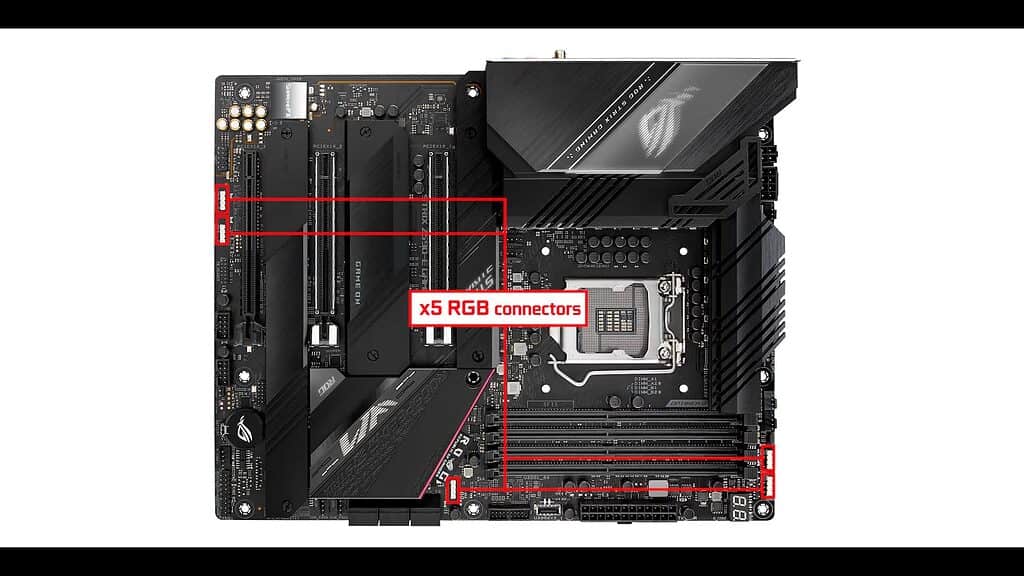
- 2 classic AURA RGB Connectors
- 3 Addressable AURA RGB Connectors
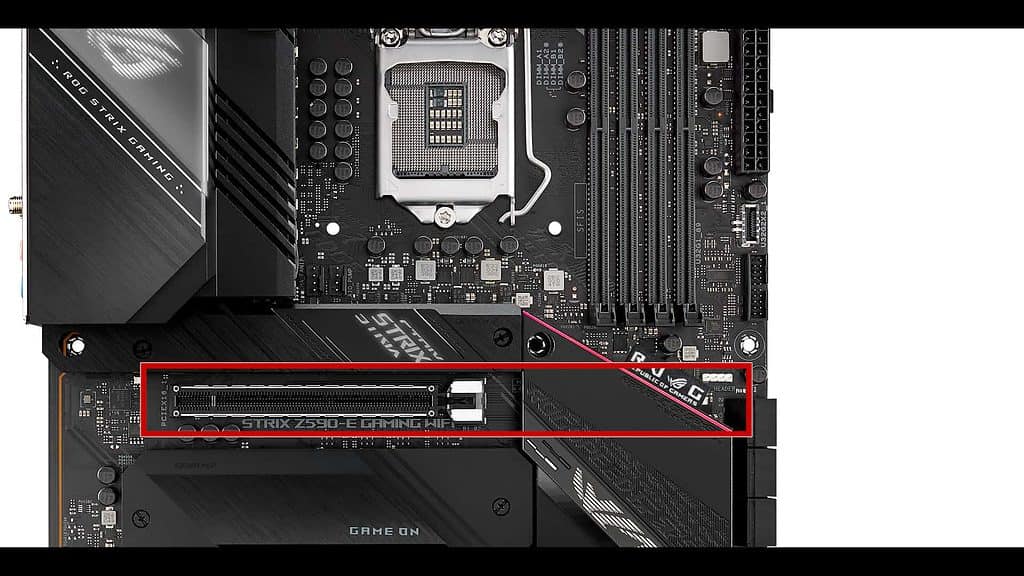
It is the first tie i see that many RGB connectors and I do not think it was necessary, especially when that fifth connector is places right on the main video-card pathway!
All of the above are obviously fully customizable (and sync-able) though ASUS proprietary AURA software or ARMOURY Crate.
CONCLUSION
The ROG STRIX Z590-E GAMING WiFi will run you around 380 USD (MSRP). About 80 dollars more than its previous iteration.
Usually, intel boards see limited improvements and upgrades generation-to-generation, and if you watched any of my Zxxx powered boards reviews, you know that I usually advice against a gen-to-gen upgrade.
But the ROG STRIX Z590-E Gaming brings quite a lot when compared to its previous Z490 iteration.
Upgraded VRM, upgrade WiFi (6E), upgrade LAN, upgraded audio, upgraded thunderbolt, upgraded m.2 SSD connectivity, and an improved PICe 4.0 support.
That is a lot!
More importantly, some of the new features makes it interesting not only to enthusiast builders and heavy gamers, but even to content creators.
That 2nd 2.5 Gbs lan, this many M.2 SSD connectors, theses DUAL type-C outputs, definitely makes the ROG STRIX Z590-E Gaming an easy board to expand and work with.
Truth is I am really excited by what I saw here, and compared to its Z490 variant, I can definitely see a solid argument for an upgrade.
QUICK OVERVIEW
CPU & northbridge support
Memory
Connectors

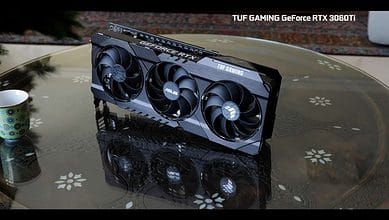
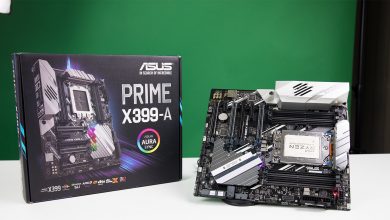
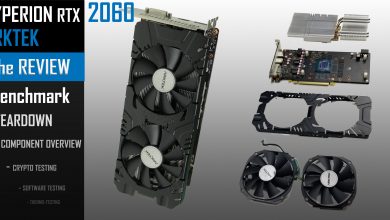
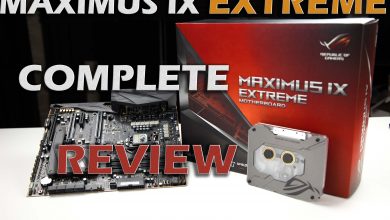
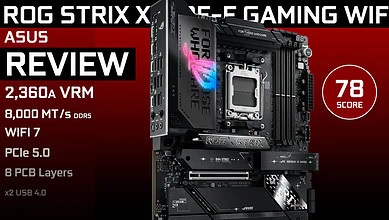
Just purchased the Z590-A Strix Gaming Wifi board and was wondering can I use the last pci-e full length slot without affecting the X16 speed of the primary X16 slot for the gpu?
Thanks
short answer is yes
So using the last slot will give you X16/x0/x4 operation?
yes
I am only getting x8 on slot 1, slot 2 is empty and 3rd slot has a creative soundcard in it. I have an nvme drive in the z590e controllers slot m2-3 socket. GPUZ reports my RTX 2080 super supports x16 but is in x8 1.1 mode.
hi laurent I do not know which motherboard I should choose I should build my computer and do not know which one I should have z490 or z590 which do you think I should buy? thanks
what use will the build be intended for?
Hi Laurent,
Really enjoyed your video.
I’m bit rusty on the latest tech and I’m getting confused on the details of each motherboard!
I was planning to get:
Z590-E
11th generation Intel processor
RTX 3090
16GB Ram 3,200 Hz
M.2 NVMe PCIe Gen. 4 x4 SSD
with the purpose to extend later to an extra RTX 3090
I’m not quite sure now if I’ll be able to take full advantage of the GPU’s & the SSD?
Obviously I understand GPU’s won’t be on 100% on gaming as are mainly for photo, video editing etc.
Would you say based on your experience that the system I’ll build will be efficient or way too much for the motherboard?
Thanks!